HiPro HP-P3017F3 rev:03
Still have reservations against the previously posted HEC Orion HP585d PSU I showed? Okay, let's compare it with something a little more standard, then. By standard, I mean an OEM unit of the same class. In this case, I picked the HiPro HP-P3017F3. It's a super-popular PSU, used frequently by many PC brands like Dell, HP, Acer, and etc. It's also a PSU I seem to get quite frequently on my bench – not because it's crap, but only because it has crap caps. So, let's have a look. First, the case, as usual:
By standard, I mean an OEM unit of the same class. In this case, I picked the HiPro HP-P3017F3. It's a super-popular PSU, used frequently by many PC brands like Dell, HP, Acer, and etc. It's also a PSU I seem to get quite frequently on my bench – not because it's crap, but only because it has crap caps. So, let's have a look. First, the case, as usual:
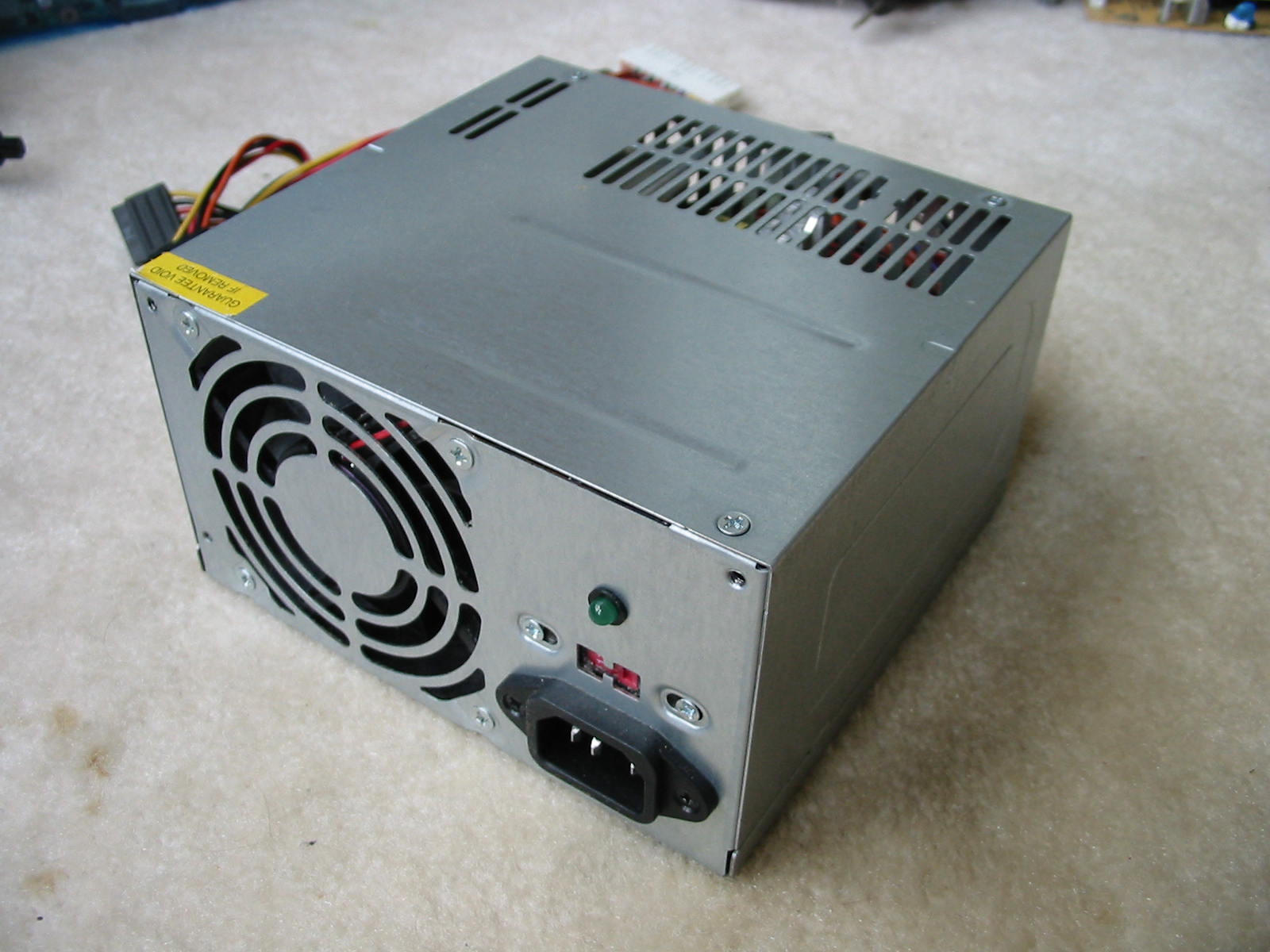
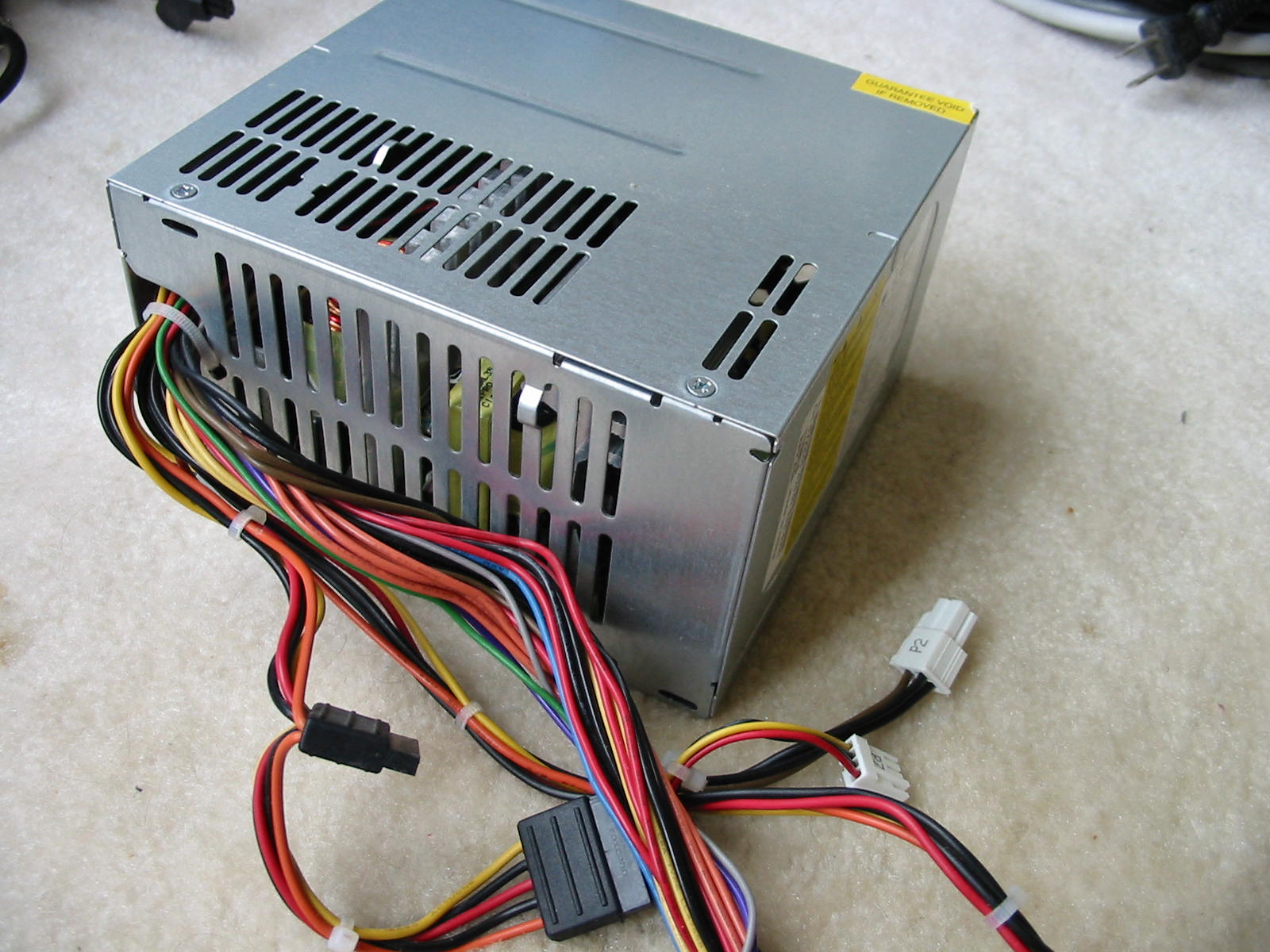
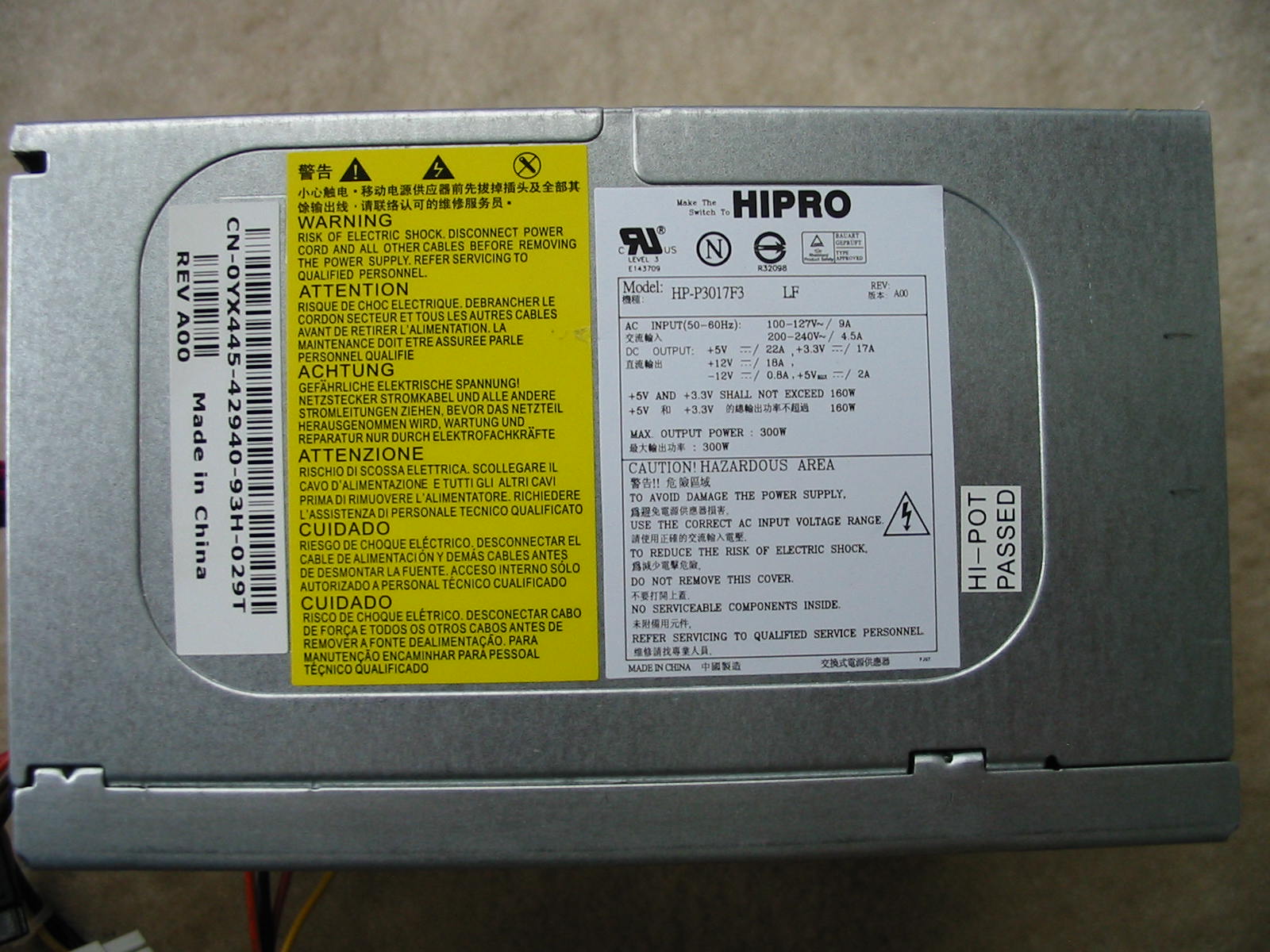
*Yawn*
It's just a 305W PSU in a plain steel case with short colorful wires and not a whole lot of connectors (only 4x SATA and a 4-pin 12V CPU connector, besides the 24-pin ATX). Booooring!
But as plain as it may seem, it does get the job done. Here is what you get inside this 300-Watter:
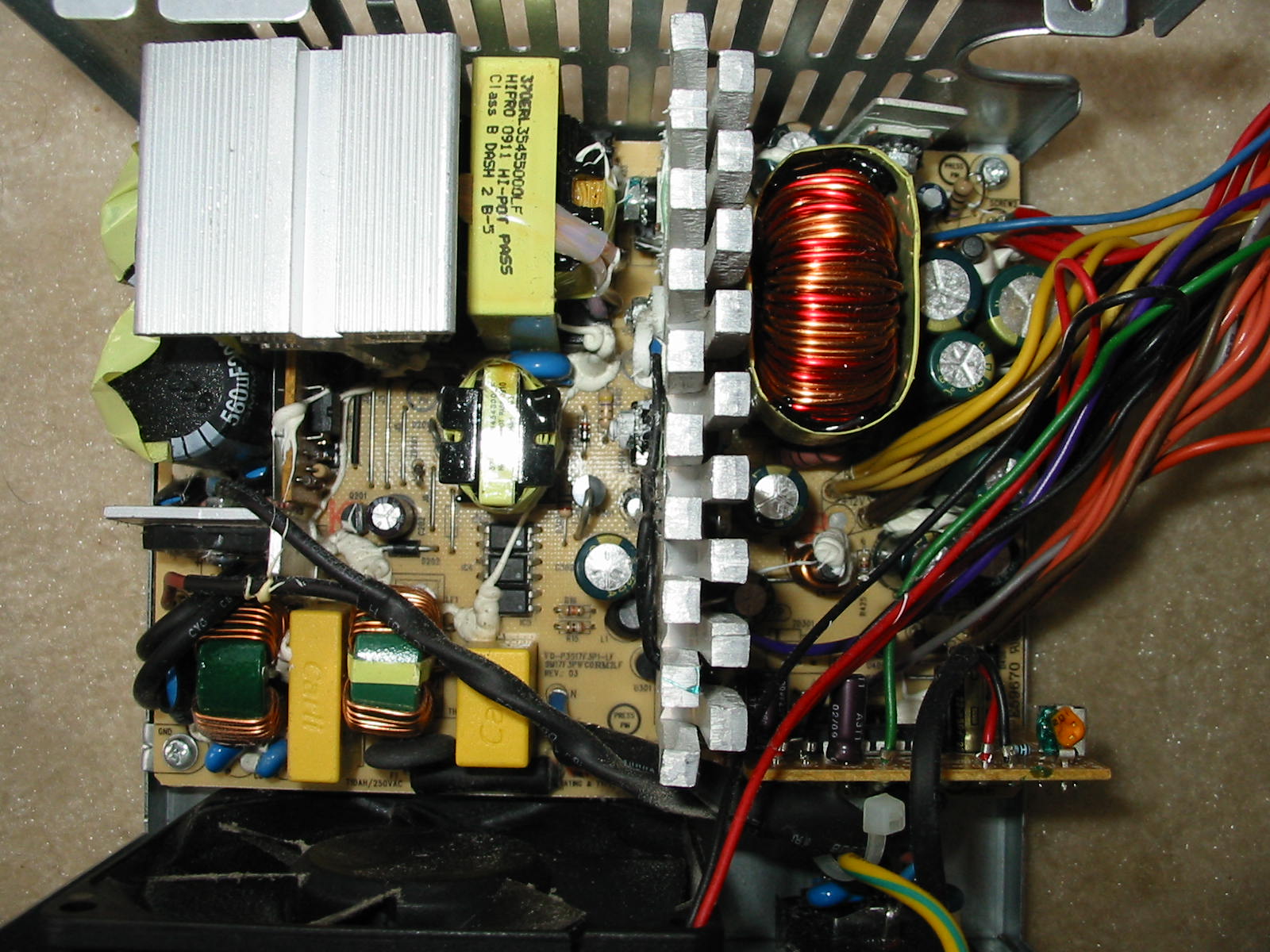
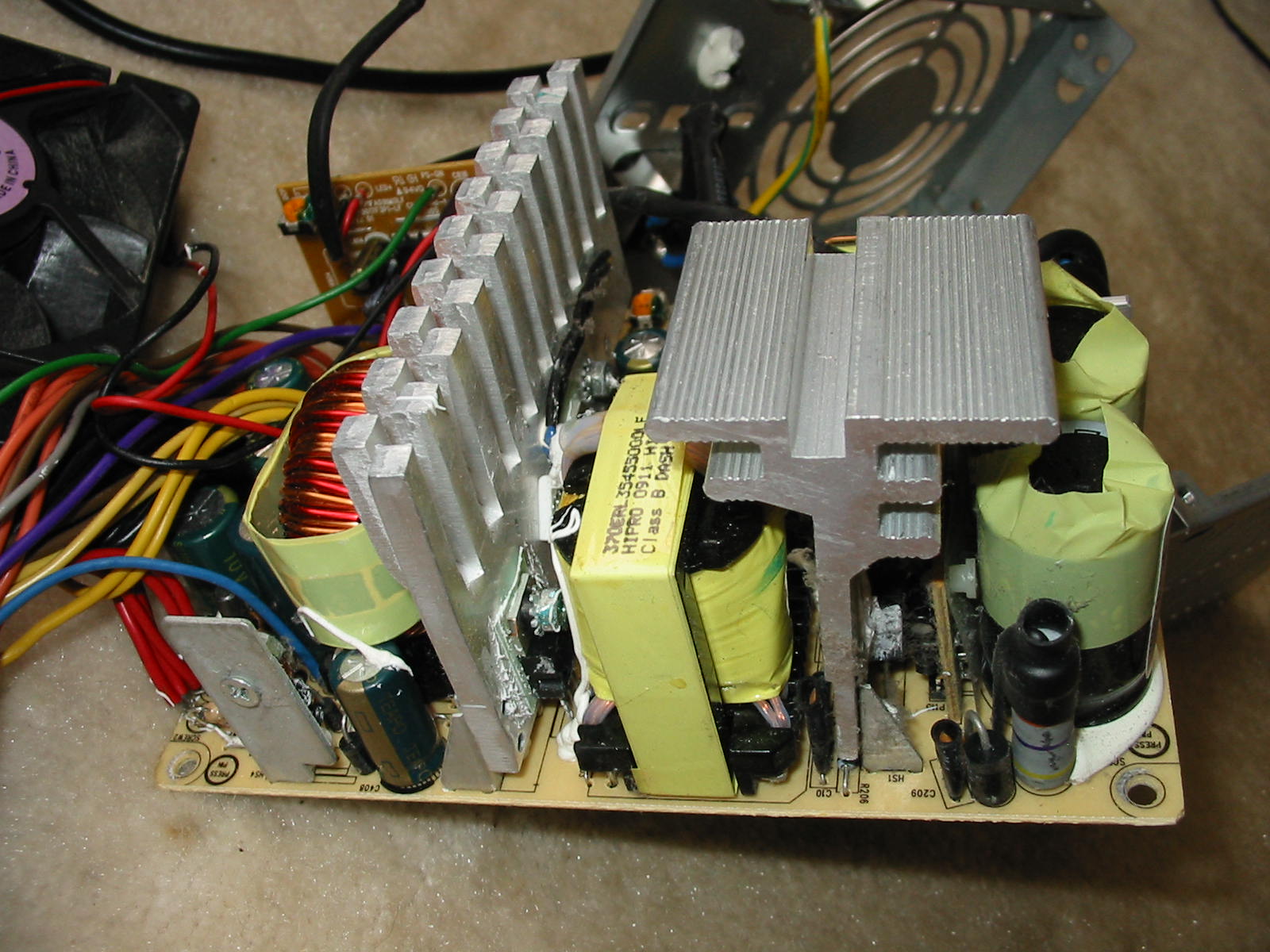
Not bad at all, right? This PSU has very thick heatsinks, good input EMI/RFI filtering (unlike the HEC Orion HP585d… though the ThermalTake TR2-430W is about the same as the HiPro above), excellent output filtering with lots of space for the output caps, nice size output torroid and… really good size everything for just a 305 Watt unit. Design-wise, it's a single-transistor forward, just like the HEC Orion posted previously. The only slight difference is in the protections: this HiPro uses a Weltrend WT7525 IC on the secondary, which also does OCP for the 12V rail (vs. the HEC Orion, which appears to have some kind of external circuit for that.) And I consider the 5VSB of this HiPro better than the HEC Orion, as it uses a TNY266PN PWMFET IC instead of a dated 2-transistor self-oscillating circuit with a risky critical cap.
Speaking of the secondary side above, here it is closer:
https://www.badcaps.net/forum/attach...1&d=1578792576
https://www.badcaps.net/forum/attach...1&d=1578792576
Yes, now you really see why I get these for repair so often: bad caps.
The particular unit above has Teapo SC caps. However, this is not the only brand/series found in these PSUs. Some also come with Ltec LZP and occasionally a Teapo SY thrown in there, along with a United Chemicon KZE for one of the caps on the 12V rail. Of course, the Teapo SC and Ltec LZP are the ones that fail most consistently – particularly on the 5VSB and 3.3V rails (though recently I got two units with failed Teapo SC caps on the 5V rail – and these are big 4700 uF caps in 12.5 mm diameter, which I haven't seen fail very often.) So in short, expect to do a full recap if you get one of these PSUs and you want 100% reliability. Aside from that and removing the large load resistor on the 12V rail that tends to cook the caps, there is nothing else that needs to be done on these units. With good caps, they are extremely reliable. Here is the one above when I recapped it (back ~2013) with caps I had on hand:
https://www.badcaps.net/forum/attach...1&d=1578792576
In case you are wondering what those black caps are: Nichicon HZ 6.3V, 2200 uF pulled from Xbox 360 motherboards. Despite being the lowest-ESR electrolytic caps (which is usually *not* recommended for PSU repair), this HiPro worked just fine with them. No squealing or hiccups (it was an experiment on my side, but it worked.) Sharp eyes may also notice I replaced that hot load resistor on the 12V rail (R422) next to the output torroid. Original value was 75 Ohms and 3-Watt power rating (because it dissipates around 2 Watts @ 12V! ) I used a single 1000-Ohm resistor, as that's all I had at the time. Could probably have even gone without, though. Getting rid of the original resistor there and using a higher value resistance is highly recommended.
) I used a single 1000-Ohm resistor, as that's all I had at the time. Could probably have even gone without, though. Getting rid of the original resistor there and using a higher value resistance is highly recommended.
Caps aside, the secondary is done in a similar way to the HEC Orion: Separate 3.3V, 5V, and 12V rails that all go to the same torroid, with the 3.3V rail being linearly-regulated through a MOSFET afterwards.
And before I finish off this post, here is a picture of the PCB / solder side:
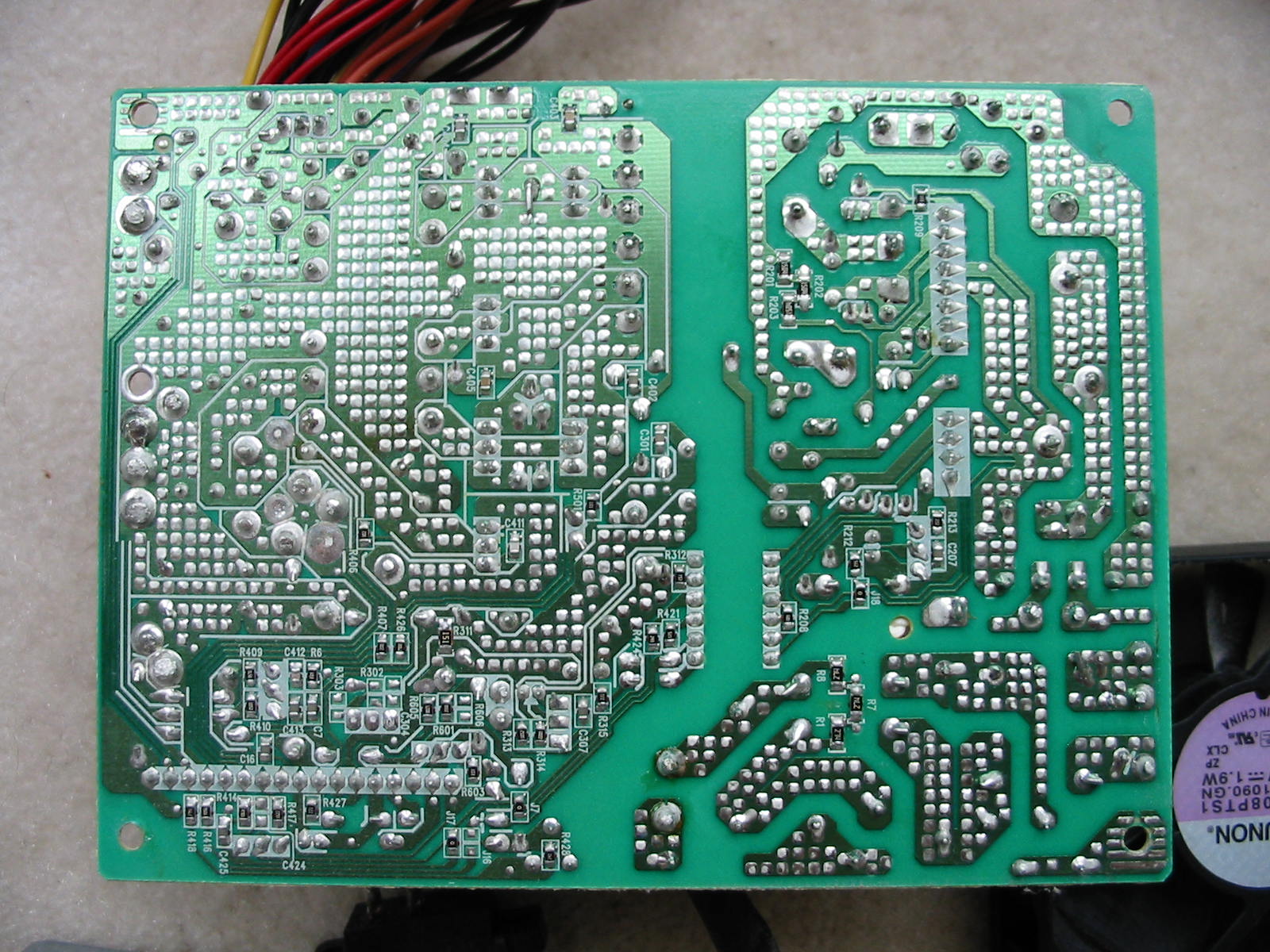
Excellent soldering, yes?
Oh, and these HiPro PSUs like to use a foam pad (for electrical insulation) on the bottom of the PSU case below the primary side.
https://www.badcaps.net/forum/attach...1&d=1578792576
Not sure if that's a good idea or not, as I'm pretty sure the foam will rot eventually and leave a mess. But at least the primary solder-side should stay dust-free (and I think this is what HiPro intended with this) for a while.
Anyways, off to a detailed part list summary…
ICs:
UC384_b (PWM controller), Weltrend WT7525 (secondary-side supervisor), TNY266PN (5VSB PWM+FET combo), and 7912 linear regulator (-12V rail)
Wiring:
* 600V, 18 AWG input wiring
* 300V, 18 AWG output wiring, except ATX connector (mostly 20 AWG)
* Output connectors: 24pin ATX, 4-pin 12V CPU, 4x SATA
Primary Side:
* Input Filtering: two 0.47 uF X2-class caps, five Y2-class caps, two CM chokes
* Input protection: 13R inrush current limiter, three MOVS for surge prot., T10AH fuse
* BU1006 bridge rectifier
* 2x 200V, 560 or 680 uF (capacity and brand varies with models), 85°C caps
Secondary Side:
* 5VSB
*** 1x Teapo SC or Ltec LZP, 10V, 2200 uF, 10x20 mm before PI coil
*** 1x Teapo SC or Ltec LZP, 10V, 470 uF, 8x13 mm after PI coil (note: space for this cap has 5 mm lead spacing and can accommodate a 10 mm diameter cap, if needed)
*** 3A (?) schottky diode for rectification
*** PI coil: 6-turn, 20-AWG, 4 mm core
* 3.3V Rail
*** 1x Teapo SC or Ltec LZP, Teapo SY, 10V, 2200 uF, 10x20 mm before linear regulator
*** 1x Teapo SC or Ltec LZP, 10V, 2200 uF, 10x20 mm after linear regulator
*** 1x Teapo SC, 10V, 1000 uF, 10x15 mm after linear regulator
*** one STPS3045 (?) rectifier and CEP703AL MOSFET for linear regulation
*** PI coil: 5.5-turn, 16-AWG, 4 mm core
*** Load resistor: 560-Ohm, 1/8 –Watt
* 5V Rail
*** 1x Teapo SC, 10V, 4700 uF, 12.5x25 mm with PI coil in between
*** two STPS3045 rectifiers in parallel
*** PI coil: 5.5-turn, 16-AWG, 4 mm core
*** Load resistor: 75-Ohm, ½ -Watt
* 12V Rail
*** 2x Teapo SC or Ltec LZP, 16V, 2200 uF, 10x30 mm
*** 1x free cap spot for 6.3 mm dia. cap with 3 mm LS
*** PI coil: NONE. Rail has current shunt only
*** Load resistor: 75-KOhm, 3-Watt!!
 -replace it!
-replace it!
*** one STPS20H100 and one STPS10H100 in parallel (but why the mismatched ratings?! )
)
* -12V Rail
*** 1x Teapo SC, 35V, 470 uF, 10x20 mm before 7912 linear regulator
*** 1x Teapo SC or Ltec LZP, 16V or 25V, 100 uF (?), 5x11 mm after 7912 linear regulator
*** PI coil: NONE
*** 1.5 or 2 Amp diode as rectifier
Fan:
(Usually, but I'm not sure if every unit has this) Sunon KD1208PTS1 rated for 1.9W @ 12V. Good quality fan, really.
https://www.badcaps.net/forum/attach...1&d=1578792722
And that's all. I'll probably create a recap thread on this PSU later on, just to make the information easier to find.
Still have reservations against the previously posted HEC Orion HP585d PSU I showed? Okay, let's compare it with something a little more standard, then.
*Yawn*
It's just a 305W PSU in a plain steel case with short colorful wires and not a whole lot of connectors (only 4x SATA and a 4-pin 12V CPU connector, besides the 24-pin ATX). Booooring!
But as plain as it may seem, it does get the job done. Here is what you get inside this 300-Watter:
Not bad at all, right? This PSU has very thick heatsinks, good input EMI/RFI filtering (unlike the HEC Orion HP585d… though the ThermalTake TR2-430W is about the same as the HiPro above), excellent output filtering with lots of space for the output caps, nice size output torroid and… really good size everything for just a 305 Watt unit. Design-wise, it's a single-transistor forward, just like the HEC Orion posted previously. The only slight difference is in the protections: this HiPro uses a Weltrend WT7525 IC on the secondary, which also does OCP for the 12V rail (vs. the HEC Orion, which appears to have some kind of external circuit for that.) And I consider the 5VSB of this HiPro better than the HEC Orion, as it uses a TNY266PN PWMFET IC instead of a dated 2-transistor self-oscillating circuit with a risky critical cap.
Speaking of the secondary side above, here it is closer:
https://www.badcaps.net/forum/attach...1&d=1578792576
https://www.badcaps.net/forum/attach...1&d=1578792576
Yes, now you really see why I get these for repair so often: bad caps.

The particular unit above has Teapo SC caps. However, this is not the only brand/series found in these PSUs. Some also come with Ltec LZP and occasionally a Teapo SY thrown in there, along with a United Chemicon KZE for one of the caps on the 12V rail. Of course, the Teapo SC and Ltec LZP are the ones that fail most consistently – particularly on the 5VSB and 3.3V rails (though recently I got two units with failed Teapo SC caps on the 5V rail – and these are big 4700 uF caps in 12.5 mm diameter, which I haven't seen fail very often.) So in short, expect to do a full recap if you get one of these PSUs and you want 100% reliability. Aside from that and removing the large load resistor on the 12V rail that tends to cook the caps, there is nothing else that needs to be done on these units. With good caps, they are extremely reliable. Here is the one above when I recapped it (back ~2013) with caps I had on hand:
https://www.badcaps.net/forum/attach...1&d=1578792576
In case you are wondering what those black caps are: Nichicon HZ 6.3V, 2200 uF pulled from Xbox 360 motherboards. Despite being the lowest-ESR electrolytic caps (which is usually *not* recommended for PSU repair), this HiPro worked just fine with them. No squealing or hiccups (it was an experiment on my side, but it worked.) Sharp eyes may also notice I replaced that hot load resistor on the 12V rail (R422) next to the output torroid. Original value was 75 Ohms and 3-Watt power rating (because it dissipates around 2 Watts @ 12V!
 ) I used a single 1000-Ohm resistor, as that's all I had at the time. Could probably have even gone without, though. Getting rid of the original resistor there and using a higher value resistance is highly recommended.
) I used a single 1000-Ohm resistor, as that's all I had at the time. Could probably have even gone without, though. Getting rid of the original resistor there and using a higher value resistance is highly recommended.Caps aside, the secondary is done in a similar way to the HEC Orion: Separate 3.3V, 5V, and 12V rails that all go to the same torroid, with the 3.3V rail being linearly-regulated through a MOSFET afterwards.
And before I finish off this post, here is a picture of the PCB / solder side:
Excellent soldering, yes?
Oh, and these HiPro PSUs like to use a foam pad (for electrical insulation) on the bottom of the PSU case below the primary side.
https://www.badcaps.net/forum/attach...1&d=1578792576
Not sure if that's a good idea or not, as I'm pretty sure the foam will rot eventually and leave a mess. But at least the primary solder-side should stay dust-free (and I think this is what HiPro intended with this) for a while.
Anyways, off to a detailed part list summary…
ICs:
UC384_b (PWM controller), Weltrend WT7525 (secondary-side supervisor), TNY266PN (5VSB PWM+FET combo), and 7912 linear regulator (-12V rail)
Wiring:
* 600V, 18 AWG input wiring
* 300V, 18 AWG output wiring, except ATX connector (mostly 20 AWG)
* Output connectors: 24pin ATX, 4-pin 12V CPU, 4x SATA
Primary Side:
* Input Filtering: two 0.47 uF X2-class caps, five Y2-class caps, two CM chokes
* Input protection: 13R inrush current limiter, three MOVS for surge prot., T10AH fuse
* BU1006 bridge rectifier
* 2x 200V, 560 or 680 uF (capacity and brand varies with models), 85°C caps
Secondary Side:
* 5VSB
*** 1x Teapo SC or Ltec LZP, 10V, 2200 uF, 10x20 mm before PI coil
*** 1x Teapo SC or Ltec LZP, 10V, 470 uF, 8x13 mm after PI coil (note: space for this cap has 5 mm lead spacing and can accommodate a 10 mm diameter cap, if needed)
*** 3A (?) schottky diode for rectification
*** PI coil: 6-turn, 20-AWG, 4 mm core
* 3.3V Rail
*** 1x Teapo SC or Ltec LZP, Teapo SY, 10V, 2200 uF, 10x20 mm before linear regulator
*** 1x Teapo SC or Ltec LZP, 10V, 2200 uF, 10x20 mm after linear regulator
*** 1x Teapo SC, 10V, 1000 uF, 10x15 mm after linear regulator
*** one STPS3045 (?) rectifier and CEP703AL MOSFET for linear regulation
*** PI coil: 5.5-turn, 16-AWG, 4 mm core
*** Load resistor: 560-Ohm, 1/8 –Watt
* 5V Rail
*** 1x Teapo SC, 10V, 4700 uF, 12.5x25 mm with PI coil in between
*** two STPS3045 rectifiers in parallel
*** PI coil: 5.5-turn, 16-AWG, 4 mm core
*** Load resistor: 75-Ohm, ½ -Watt
* 12V Rail
*** 2x Teapo SC or Ltec LZP, 16V, 2200 uF, 10x30 mm
*** 1x free cap spot for 6.3 mm dia. cap with 3 mm LS
*** PI coil: NONE. Rail has current shunt only
*** Load resistor: 75-KOhm, 3-Watt!!

 -replace it!
-replace it!*** one STPS20H100 and one STPS10H100 in parallel (but why the mismatched ratings?!
 )
)* -12V Rail
*** 1x Teapo SC, 35V, 470 uF, 10x20 mm before 7912 linear regulator
*** 1x Teapo SC or Ltec LZP, 16V or 25V, 100 uF (?), 5x11 mm after 7912 linear regulator
*** PI coil: NONE
*** 1.5 or 2 Amp diode as rectifier
Fan:
(Usually, but I'm not sure if every unit has this) Sunon KD1208PTS1 rated for 1.9W @ 12V. Good quality fan, really.
https://www.badcaps.net/forum/attach...1&d=1578792722
And that's all. I'll probably create a recap thread on this PSU later on, just to make the information easier to find.
 I had the PSU in front of me, and it fooled me for sure, because the size of the 4700 uF Teapo SC is the same as that of the 3300 uF one, so I wrongly assumed both are the same caps. Go figure.
I had the PSU in front of me, and it fooled me for sure, because the size of the 4700 uF Teapo SC is the same as that of the 3300 uF one, so I wrongly assumed both are the same caps. Go figure.  Agreed.
Agreed.





 ) and found the caps I pulled out of this PSU. They were all Ltec, indeed.
) and found the caps I pulled out of this PSU. They were all Ltec, indeed. I thought I posted this already, but I guess not.
I thought I posted this already, but I guess not. In particular, it's the first 5VSB output cap and the second cap on the 5V rail. Needless to say, this power supply has been fully recapped and put back into a working PC. I'll save the recap info for another thread/post, though.
In particular, it's the first 5VSB output cap and the second cap on the 5V rail. Needless to say, this power supply has been fully recapped and put back into a working PC. I'll save the recap info for another thread/post, though.
Comment